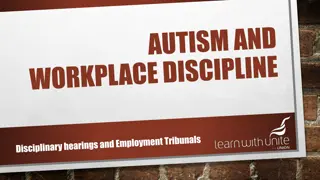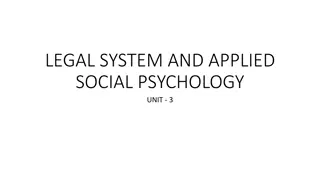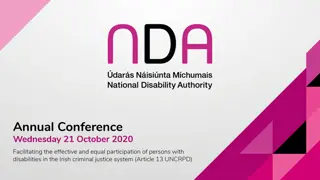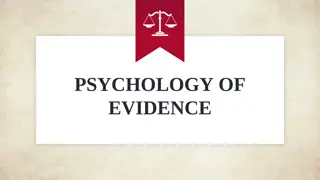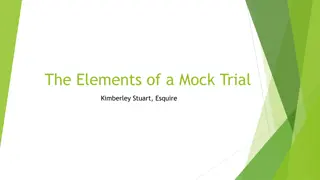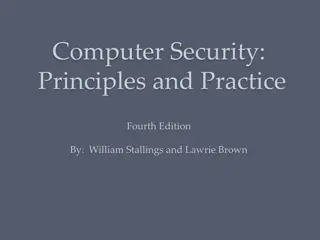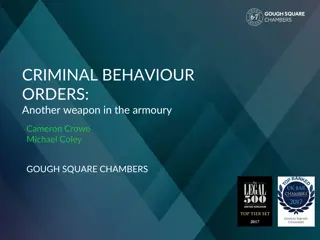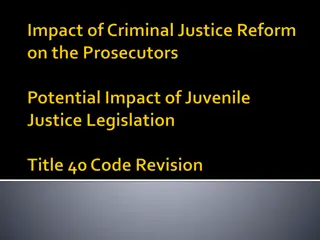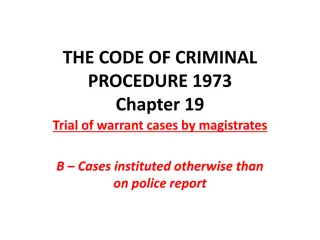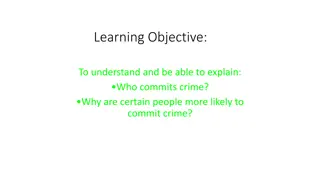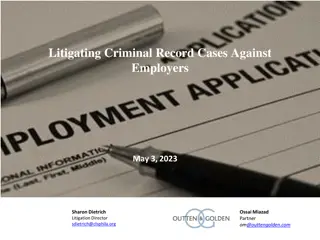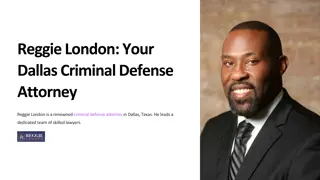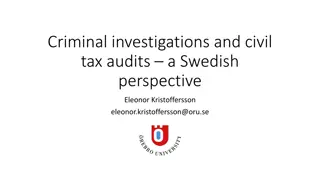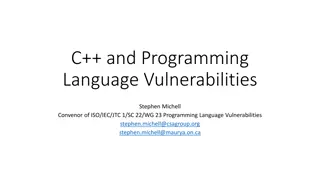Understanding Alibi Evidence in Criminal Cases: Reliability, Believability, and Vulnerabilities
Explore the complexities of alibi evidence in criminal cases, delving into the factors that determine the strength of an alibi and the challenges faced in assessing its reliability. Discover the impact of physical evidence, witness credibility, and systemic barriers on the believability of alibis, shedding light on the intricacies of wrongful convictions and the importance of robust investigative practices.
Download Presentation

Please find below an Image/Link to download the presentation.
The content on the website is provided AS IS for your information and personal use only. It may not be sold, licensed, or shared on other websites without obtaining consent from the author. Download presentation by click this link. If you encounter any issues during the download, it is possible that the publisher has removed the file from their server.
E N D
Presentation Transcript
Reliability, Believability, and Vulnerability of Alibi Evidence Stephanie Marion, PhD York University September 18th, 2023
Willie Veasy Drive-by shooting on January 24, 1992 Eyewitness IDs Veasy from a photo lineup after multiple attempts Veasy was interrogated on June 9th His alibi: playing basketball with friends False confession: friend wanted revenge A few days later, evidence was found that he was at work, washing dishes at a busy restaurant Alibi discounted by investigators Veasy convicted of second-degree murder
Alibi Evidence What makes a strong alibi? Why characteristics of a weak alibi are not diagnostic of deceitful alibis What can be done to strengthen alibi evidence Systemic and psychological barriers to generating and using alibi evidence
We know alibi evidence often fails 20 68% of wrongfully convicted individuals had alibis (Burke et al., 2007; Garrett, 2011; Heath et al., 2021; Wells et al., 1998) Not 100%? Sometimes determined to be contributing to the wrongful conviction weak alibi What is a weak alibi? Not corroborated by any physical evidence Corroborated by only motivated witness evidence (Olson & Wells, 2004) Motivated to lie (e.g., to protect the suspect, out of fear of suspect retaliation, financial gain) Close social and familial relationships Contains inconsistencies
What kind of alibi is most believable? The most persuasive alibis are those that are: 1. Corroborated by physical evidence (e.g., Dysart & Strange, 2012; Olson & Wells, 2004; Nieuwkamp et al., 2022) 2. Corroborated by non-motivated others (e.g., Olson & Wells, 2004) 3. Consistent alibis (e.g., Culhane & Hosch, 2012; Dysart & Strange, 2012) 4. Corroborated by multiple witnesses (e.g., Eastwood et al., 2013; 2016) 5. Corroborated by knowledge evidence (e.g., Nieuwkamp et al., 2022)
Physical evidence supporting alibis Police estimates: Only present in 14-25% of investigations (Dysart & Strange, 2012; Turtle & Burke, 2003) Even when it exists, physical evidence is not always easy to obtain Only as good as a suspect s memory Advantages the privileged / disadvantages the vulnerable (Levine & Miller, 2021)
Motivated alibi corroborators Experimental behavioural data supports the general belief: Marion & Burke (2013; 2017) Alibis corroborated only by motivated witnesses are sometimes not rated as more believable than non- corroborated alibis (e.g., Dahl et al., 2009; Strange et al., 2014)
Dysart & Strange, 2012 Your average alibi 60 50 Survey of US police officers (N = 68); varying ranks % of suspects alibis 40 Belief that suspects lie 78% of the time 30 20 Thus; may reflect sample of mostly false alibis 10 0
Olson & Charman, 2012 Your average alibi 100 90 80 Weakly corroborated alibis are the most common form of alibi evidence among innocent suspects , based on self-report experiments 70 60 50 40 30 20 10 0 Initial memory Motivated witnesses Non-motivated witnesses Physical evidence Recent past Distant past
Nieuwkamp et al., 2017 Your average alibi 100 90 80 Weakly corroborated alibis are the most common form of alibi evidence among innocent suspects , based on self-report experiments Multiple witnesses: 28% - 64% (e.g., Culhane et al., 2008; Nieuwkamp et al., 2017) 70 % of true alibis 60 50 40 30 20 10 0 Motivated witnesses Non-motivated witnesses Multiple wintesses Physical evidence Knowledge evidence Recent past
Your average alibi Culhane et al., 2008 (self-reported); Culhane et al., 2013 (validated) 100 90 80 70 60 50 % 40 30 20 10 0 Witness evidence Non-motivated witnesses Physical evidence Multiple witnesses Deceptive Motivated witnesses Non-motivated witnesses Physical evidence Honest
Alibi consistency: Base rate of mistaken alibis Police may underestimate the likelihood of honestly mistaken alibis (1 in 5) (Dysart & Strange, 2012) Leins & Charman (2016) experiment: only 11% accurate when suspect engaged in non- schema-consistent behaviour; 83% accurate when schema-consistent Olson & Charman (2012): 12% of innocent individuals initially reported completely inaccurate alibis Cardenas et al., 2020: Errors about who, where, AND what: 22% Errors about who, where, OR what: 50% => Only 10% of potential corroborating pieces of evidence could be obtained
Alibi for a 6-hr period 3 weeks prior; investigated and re-told 1 week later Your average alibi 60 50 Strange et al., 2014 40 Inconsistent alibis of innocent individuals appear to be the norm, not the exception 30 % 20 11.5% needed a whole narrative change 10 24.9% needed evidence change 0 What When Who Where Before After Inconsistent Partially consistent Consistent
Inconsistent alibis Consistency is a key ingredient to believability Any kind of change is met with skepticism Police estimate that 4 in 5 changed alibis is indicative of a suspect lying Yet consistency is NOT diagnostic of true alibis False and rehearsed alibis have the potential to be more consistent than true alibis (Sakrisvold et al., 2017) Alibi changes due to an attempt to cover up illegal or immoral behaviour may be better tolerated than changes due to memory errors! (Nieuwkamp et al., 2016) Offering a mistaken alibi early in an investigation can set forensic confirmation bias into motion
BELIEVABILITY CRITERIA ARE NOT DIAGNOSTIC OF TRUTHFULNESS
Types of Alibis True Mistaken False Likely based on part on memories Based on accurate memories Memory failures
An alibi is a memory Autobiographical memory => Mental time travel Cognitive and social factors that influence the availability and reliability of memories Encoding Storage Retrieval Imagination inflation of a false alibi makes the memory of a false alibi just as vivid and convincing as a true alibi (Dhammaperra et al., 2020) The validation of an alibi is also largely dependent on memory Person evidence Recollection of potential physical evidence Credit: University of Washington Magazine
Why are good alibis so hard to generate? Time Reliance on schemas (in whole or in part) may lead to errors Reliance on schemas increases confidence (e.g. Leins & Charman, 2016) Mundane or repeat experiences are not well encoded => Source monitoring errors Motivation CANNOT improve memory Innocence itself may lower the threshold for reporting a memory Retention Time
Difficulty of validating an alibi The burden of validation of an alibi is sometimes on the defendant Dysart & Strange (2012): police investigate alibis 76% of the time; only 49% of officer believed a thorough investigation of a suspect s alibi is always done before an arrest is made Existing alibi evidence is not accessible to everyone / needs law enforcement or private defense to intervene Only 1/3 of state and federal judges believe that failing to investigate or disclose a defendant s alibi should be investigates as possible prosecutorial misconduct (Cardenas et al., 2022) Some good news: When alibi evidence IS strong, it has the potential to counteract persuasive evidence (e.g., DNA match probability evidence, Ribeiro et al., 2020)
How alibi evidence can be strengthened Reduce reliance on schemas; allow memory aids Matuku & Charman (2021) 3 minutes of memory aids in true alibis (16% 51%) in mistaken alibis Potentially warning suspects about the detrimental effect of mistaken alibis
How alibi evidence can be strengthened Increase potential for corroborating evidence by drawing on principles of human memory (e.g., Mosser & Evans, 2019) E.g., Cognitive Interview strategies: Context reinstatement Forward vs Backward recounting Multiples perspective Potentially beneficial for alibi generation AND validation Matuku & Charman (2020)
Believability of suspect alibi 8 How alibi evidence can be strengthened 7 6 5 Alibi Generation Effect (Olson & Wells, 2012) 4 3 Research participants rate a suspect s alibi as more believable when they have the opportunity to generate their own first 2 1 0 Generate-first Evaluate-first
How alibi evidence can be strengthened Increase detection of true vs false alibis Like any other type of lie detection, detection of false alibis is low (43 60%, Culhane et al., 2013; ) Verifiability Approach: Truth-telling pairs offer proportionately more verifiable information than lying pairs (Nahari & Vrij, 2014; Vernham et al., 2020) Training on the verifiability approach for judging collective statements appears promising Anecdotally, a thorough interview by the defense attorney can often spot lying alibi corroborators (Levine & Miller, 2021)
How alibi evidence can be strengthened Investigative training and resources Only 23% of U.S. police respondents in Dysart & Strange (2012) reported receiving training on how to interview alibi witnesses: Police investigate alibis 76% of the time and 14% reported that alibis are rarely or only sometimes investigated before an arrest or warrant Inquiry Regarding Thomas Sophonow: Police should investigate alibi evidence, and take the same care as to not contaminate witness evidence as with suspect and eyewitness interviews Alibi witnesses should not be suggested that they are mistaken; they should not be threatened or intimidated
Systemic corruption of alibi evidence Levine & Miller (2021): Survey of U.S. Defense attorneys Strong alibis are likely to be presented to the DA before trial, but if the alibi depends on testimony from a witness that the DA s office can find and lean on with threats of VOPs or calling DFACS to their children, then I tend to play those cards a little closer to the vest. 75% of defense attorneys surveys believed that the police and/or prosecutors regularly blur the timeline of the crime with the specific goal of hindering the establishment of an alibi. Flipped burden of proof? (See also Burchill, 2018)
Systemic corruption of alibi evidence Moore et al. (2014): coercive interrogations of eyewitnesses and alibi witnesses Eric Morgan (aka Action ); Brampton, ON, 2006 Reid technique used: Eyewitness non-ID became an ID Alibi witness recanted corroboration
Systemic corruption of alibi evidence Marion et al. (2016) experimental data: Alibi witnesses recant their corroboration of a true alibi when: informed of a confession (53% ) collusion is implied (79% )
Systemic corruption of alibi evidence Marion et al. (2016) experimental data David Milgaard With friends on the morning of the murder of Gail Miller Friends Ron Wilson and Nichol John initially corroborated the alibi After several police interviews (interrogations?), both recanted the alibi and incriminated David
Systemic corruption of alibi evidence Marion et al. (2016) experimental data David Milgaard John Kogut Friends initially corroborated his alibi that he was at his girlfriend s birthday party When informed of Kogut s confession, they no longer corroborated his alibi, apparently doubting their memory
THE GOOD NEWS: RESEARCH ON ALIBI EVIDENCE STEADILY INCREASING 2020 2029 Thank you! Stephanie Marion marionst@glendon.yorku.ca
REFERENCES Burke, T. M., Turtle, J.W., & Olson, E. A. (2007). Alibis in criminal investigations and trials. In M. P. Toglia, J. D. Read, D. F. Ross, & R. C. L. Lindsay (Eds.), The handbook of eyewitness psychology ( Memory for events ) (Vol. 1, pp. 157 174). Lawrence Earlbaum Associates. Culhane, S. E., & Hosch, H. M. (2012). Changed alibis: Current law enforcement, future law enforcement, and layperson reactions. Criminal Justice and Behavior, 39, 958 977. https://doi. org/10.1177/0093854812438185 Dysart, J. E., & Strange, D. (2012). Beliefs about alibis and alibi investigations: A survey of law enforcement. Psychology, Crime and Law, 18(1), 11 25. https://doi.org/10.108 0/1068316X.2011.562867 Eastwood, J., Snook, B., & Au, D. (2016). Safety in numbers: A policy-capturing study of the alibi assessment process. Applied Cognitive Psychology, 30(2), 260 269. https://doi.org/10.1002/ acp.3200 Garrett, B. L. (2011). Convicting the innocent: Where criminal prosecutions go wrong. Harvard Univ. Press. Heath et al., 2021; Levine, K. L. & Miller, C. (2012). The strategic use of alibi defenses. Emory Legal Studies Research Paper, 21(1), http://dx.doi.org/10.2139/ssrn.3798769 Marion, S. B., Kukucka, J., Collins, C., Kassin, S., & Burke, T. M. (2016). Lost proof of innocence: The impact of confessions on alibi evidence. Law and Human Behavior, 40, 65-71. doi: 10.1037/lhb0000156 Matuku, K., & Charman, S. D. (2020). Enhancing innocent suspects memories for corroborating alibi evidence. Psychology, Public Policy, and Law, 26(4), 442. https://doi.org/10.1037/ law0000264 Moore, T.E., Cutler, B.L., & Shulman, D. (2014). Shaping eyewitness and alibi testimony with coercive interview practices. The Champion, Oct. 34-42. Nieuwkamp, R., Horselenberg, R., & van Koppen, P. (2022). You don't know: knowledge as supportive alibi evidence. Psychiatry Psychology and Law. Advance online publication. https://doi.org/10.1080/13218719.2022.2116608 Olson, E. A., & Wells, G. L. (2004). What makes a good alibi? A proposed taxonomy. Law and Human Behavior, 28(2), 157 176. https://doi.org/10.1023/B:LAHU.0000022320.47112.d3 Ribeiro, G., Tangen, J., & McKimmie, B. (2020). Does DNA evidence in the form of a likelihood ratio affect perceivers sensitivity to the strength of a suspect s alibi? Psychonomic Bulletin & Review, 27, 1325 1332. https://doi.org/10.3758/s13423-020-01784-x Wells, G. L., Small, M., Penrod, S., Malpass, R. S., Fulero, S. M., & Brimacombe, C. E. (1998). Eyewitness identification procedures: Recommendations for lineups and photospreads. Law and Human Behavior, 22(6), 603 647.




